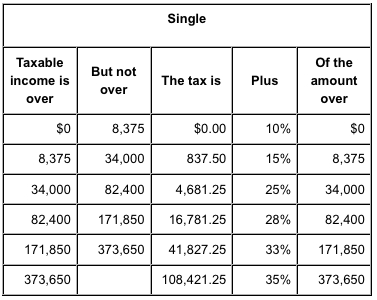I’ve written about Roth Mania and will stick to my premise, that conversion to Roth makes sense for some people, not all, and rarely a whole conversion of all of one’s IRA balance. Today, I’ll share the story of a woman whose taxes I do. She is retired, a widow, and has an IRA with an otherwise growing RMD (Required Minimum Distribution.) The RMD is based on the number of years the actuarial tables say you have left on this earth. As an example, at 70-1/2, your first RMD is 3.6% of your IRA balance, at 75, it’s 4.4%, and by 80, it creeps up to 5.3%. This doesn’t seem too bad, but in normal times, if the market is growing at even a modest 6-7%, the balance in the account is growing as well, and the dollar amount you must withdraw at 80 may be two or three times what you had to withdraw at 70. Years ago, when I first did this woman’s taxes, I observed that she was in the 15% bracket and had about $9,000 or so before she’d hit 25%. So, each year since then, we’ve done a dry run of her numbers, and converted just enough to put her in the 25% bracket. When the final numbers are in, we recharacterize so the taxable income line precisely matches the dollar amount where 15% ends and 25% begins. Got that?
A graph over the years might be cool, but I’ll just offer the tax table from Fairmark, (my thanks to Kaye Thomas for the ok to copy it) a publisher of financial books focusing on taxes and retirement accounts. You can see above, in 2010 any amount over $34,000 is taxed at 25% , but the prior dollar was taxed at just 15%. This strategy of “Topping off” her 15% each year will keep her RMD from growing and forcing her into the 25% bracket. Also, the Roth balances will pass to her heirs on her death, tax free (she’s well under any estate tax concerns) but they will need to take RMDs regardless of their age. Any thoughts on this strategy, I’d love to hear from you.
Joe


Another alternative we used with wealthier/healthy clients is to top off but use the excess unneeded money and purchase a policy within an ILIT. There won’t be RMDs for the next generation and she can leave a legacy.
I’d be curious what kind of premium you’d see on an 80 year old. I know what an ILIT is, what kind of insurance are you putting in it?
Don’t think this would work on an 80 year old. More like a 70 to 75 year old that doesn’t need all the money. But to answer your specific question it would likely be a universal life product since most States don’t allow for term to 100 (rather most states are Term to 80).